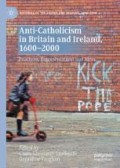Abstract
This conclusion will explore issues of longue durée continuity and change in anti-Catholicism initially through a summary of some key insights from the earlier chapters. Taken together these point to a long-term shift in anti-Catholicism from a cultural consensus on the eighteenth century to relative marginality in the twentieth. This was not, however, a straightforward process of linear decline, as is demonstrated by closer attention to the nineteenth century, focused particularly on three pivotal events, the Union of the British and Irish Parliaments (1800), Catholic Emancipation (1829) and the restoration of the Catholic hierarchy in England and Wales (1850). The Union of 1800 brought Britain into direct political connection with predominantly Catholic Ireland, with its increasingly embattled staunchly Protestant minority, thus establishing new dynamics in anti-Catholicism across the United Kingdom as a whole. Catholic Emancipation was a paradoxical event, a seeming triumph for toleration but one that was followed by a substantial and prolonged anti-Catholic backlash. The restoration of the hierarchy gave Catholicism renewed institutional status, but at the expense of the widespread condemnation of “papal aggression” that was a perceived violation of national sovereignty. During the twentieth century, however, anti-Catholicism became more localised and secular in character.
Access this chapter
Tax calculation will be finalised at checkout
Purchases are for personal use only
Notes
- 1.
William Wilberforce, A Practical View of the Prevailing Religious System of Professed Christians contrasted with Real Christianity with an Introductory Essay by the Rev. Daniel Wilson (Glasgow: Collins, 1826), lxvii.
- 2.
Alexandra Walsham, Charitable Hatred: Tolerance and Intolerance in England 1500–1700 (Manchester: Manchester University Press, 2006).
- 3.
Edmund Gosse, Father and Son (Harmondsworth, Penguin, 1970; first published 1907), 66.
- 4.
For my own previous thinking on the longue durée of anti-Catholicism, see my publications cited previously, Chap. 1, footnotes 1 and 5; also John Wolffe, “Change and Continuity in British Anti-Catholicism, 1829–1982,” in Catholicism in Britain and France since 1789, ed. Frank Tallett and Nicholas Atkin (London: Hambledon, 1996), 67–83.
- 5.
Nineteenth-century anti-Catholicism began to receive substantial scholarly attention in the 1960s. G.F.A. Best, “Popular Protestantism in Victorian Britain,” in Ideas and Institutions of Victorian Britain, ed. R. Robson (London: Bell, 1967), 115–142 and E.R. Norman, Anti-Catholicism in Victorian England (London: Allen & Unwin, 1968) are accessible introductions. W.L. Arnstein, Protestant versus Catholic in Mid-Victorian England (Columbia, MO: University of Missouri Press, 1982) concentrates particularly on the campaign against convents and the Murphy Riots of the 1860s. John Wolffe, The Protestant Crusade in Great Britain, 1829–1860 (Oxford: Clarendon Press, 1991) and D.G. Paz, Popular Anti-Catholicism in Mid-Victorian England (Stanford, CA: Stanford University Press, 1992) focus respectively on the political and organisational, and popular dimensions. Significant local studies include Frank Neal, Sectarian Violence: The Liverpool Experience, 1819–1914 (Manchester: Manchester University Press, 1988), Jonathan Bush, “Papists” and Prejudice: Popular Anti-Catholicism and Anglo-Irish Conflict in the North East of England, 1845–1870 (Newcastle-upon-Tyne: Cambridge Scholars Publishing, 2013) and Mark Doyle, Fighting Like the Devil for the Sake of God: Protestants, Catholics and the Origins of Violence in Victorian Belfast (Manchester: Manchester University Press, 2009). For Scotland see the references in Chap. 13.
- 6.
Wolffe, Protestant Crusade, 13–14.
- 7.
Wolffe, Protestant Crusade, 15–16.
- 8.
See Desmond Bowen, The Protestant Crusade in Ireland 1800–1870 (Dublin: Gill & Macmillan, 1978) and Irene Whelan, The Bible War in Ireland: The “Second Reformation” and the Polarization of Catholic-Protestant Relations 1800–1840 (Madison: University of Wisconsin Press, 2005).
- 9.
Quoted in Bowen, Protestant Crusade in Ireland, 89.
- 10.
Miriam Moffitt, Soupers and Jumpers: The Protestant Missions in Connemara 1848–1937 (Dublin: Nonsuch, 2008).
- 11.
For further details of the and other mid-nineteenth-century developments summarised in this chapter, see Wolffe, Protestant Crusade.
- 12.
Quoted in Norman, Anti-Catholicism in Victorian England, 159–160.
- 13.
Wolffe, Protestant Crusade, 243–244.
- 14.
For the Anglo-Catholic movement see John Shelton Reed, Glorious Battle: The Cultural Politics of Anglo-Catholicism (Nashville: Vanderbilt University Press, 1996) and for reaction to it James Bentley, Ritualism and Politics in Victorian Britain: The Attempt to Legislate for Belief (Oxford: Oxford University Press, 1978) and Martin Wellings, Evangelicals Embattled: The Responses of Evangelicals in the Church of England to Ritualism, Darwinism and Theological Liberalism 1890–1930 (Carlisle: Paternoster, 2003).
- 15.
John Wolffe, “Anti-Catholicism and the British Empire, 1815–1914,” in Empires of Religion, ed. Hilary M. Carey (Basingstoke: Palgrave Macmillan, 2008), 43–63. The imperial dimension of anti-Catholicism is also the subject of a forthcoming book by Geraldine Vaughan.
- 16.
Adrian Hastings, A History of English Christianity, 1920–1985 (London: Collins, 1987), 226. The bridegroom in question was the classical scholar E.R. Dodds, who was marrying Annie Edwards Powell, daughter of Canon Astell Drayner Powell.
- 17.
“Papal visit: Thousands protest against Pope in London,” https://www.bbc.co.uk/news/uk-11355258 (accessed January 31, 2020).
- 18.
David Batty, “Lady Warsi Claims Islamophobia is Now Socially Acceptable in Britain,” https://www.theguardian.com/uk/2011/jan/20/lady-warsi-islamophobia-muslims-prejudice (accessed January 31, 2020).
Author information
Authors and Affiliations
Corresponding author
Editor information
Editors and Affiliations
Rights and permissions
Copyright information
© 2020 The Author(s)
About this chapter
Cite this chapter
Wolffe, J. (2020). Conclusion: Taking the Long View of Anti-Catholicism. In: Gheeraert-Graffeuille, C., Vaughan, G. (eds) Anti-Catholicism in Britain and Ireland, 1600–2000. Histories of the Sacred and Secular, 1700–2000. Palgrave Macmillan, Cham. https://doi.org/10.1007/978-3-030-42882-2_17
Download citation
DOI: https://doi.org/10.1007/978-3-030-42882-2_17
Published:
Publisher Name: Palgrave Macmillan, Cham
Print ISBN: 978-3-030-42881-5
Online ISBN: 978-3-030-42882-2
eBook Packages: HistoryHistory (R0)

